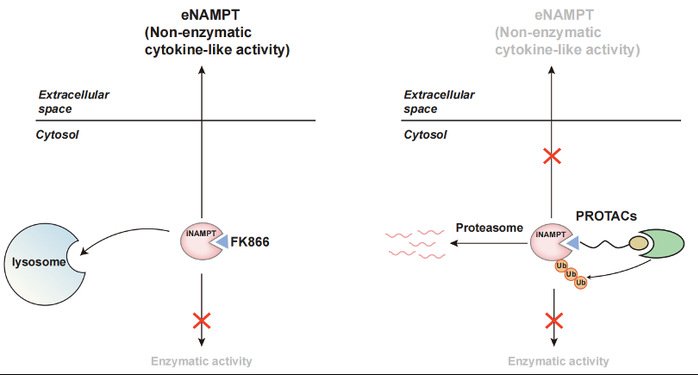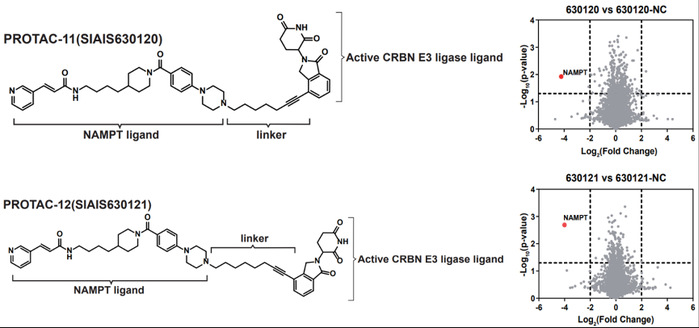As an important small molecule metabolite, NAD+ is widely involved in a series of biochemical reactions in cell energy metabolism, such as glycolysis, oxidative phosphorylation, and fatty acid oxidation. Tumor cells proliferate faster and are prone to DNA damage, requiring more NAD+ consumption. NAMPT is a key rate-limiting enzyme for NAD+ synthesis. Aberrant overexpression of NAMPT has been reported in a variety of tumor cells and is a poor prognosis factor for patient survival. It plays an important role in tumor cell proliferation, acting concurrently as an NAD+ synthase and unexpectedly, an extracellular signaling molecule for several tumor-promoting pathways. While previous efforts to modulate NAMPT activity were limited to enzymatic inhibitors with low success in clinical studies, protein degradation offers the possibility to simultaneously disrupt NAMPT's enzyme activity and ligand capabilities.
SLST Assistant Professor Fan Gaofeng's lab, in collaboration with Gluetacs Therapeutics (Shanghai) Co., Ltd., have developed two NAMPT-targeting PROTAC (Proteolysis targeting chimeric) compounds, which have been designed to achieve specific clearance of both intracellular and extracellular forms of NAMPT in a broad spectrum of tumor cell lines, thus interfering with the metabolic fitness of tumor cells. Their results were published in a paper entitled "Addressing Enzymatic-Independent Tumor-Promoting Function of NAMPT via PROTAC-Mediated Degradation" on November 2, which will be selected as the cover article in Cell Chemical Biology (Issue 11).

The action mode of NAMPT-PROTAC
The researchers used a standard structure-activity relationship study for better design of NAMPT-targeting PROTAC compounds. A series of alkyl and PEG linkers with different lengths were incorporated to bridge the NAMPT inhibitor precursor FK866-A with the CRBN ligand. The team ended up with two highly effective PROTAC compounds, called 630120 and 630121. Both compounds exhibited minimal off-target side effects on other proteins as assessed by mass spectrometry.

Chemical structure and specificity of 630120 and 630121
Both PROTAC compounds enable efficient degradation of the NAMPT protein in hematologic tumor cell lines and can affect the secretion process by degrading iNAMPT, ultimately leading to a decrease in eNAMPT levels. eNAMPT has a growth factor-like effect that activates downstream NF-κB and MAPK-ERK signaling pathways. Therefore, the PROTAC-mediated decrease in eNAMPT levels can effectively inhibit the NF-κB and ERK signaling pathway activation of tumor cells, and show superior killing effect to inhibitors in acute leukemia cells.
In summary, two NAMPT-targeting PROTAC compounds have been designed to achieve NAMPT degradation in a broad spectrum of tumor cell lines, thus interfering with the metabolic fitness of tumor cells. This study emphasizes the importance and feasibility of applying PROTACs as a superior strategy for targeting proteins with multiple tumor-promoting functions like NAMPT, which are not easily achieved by conventional enzymatic inhibitors.
First-year Ph.D. candidate Zhu Xiaotong, third-year Ph.D. candidate Liu Haixia, and third-year Ph.D. candidate Chen Li are the co-first authors. Prof. Fan Gaofeng, Prof. Jiang Biao, and Dr. Yang Xiaobao of Gluetacs are the co-corresponding authors.
**This news article is provided by Prof. Fan Gaofeng

